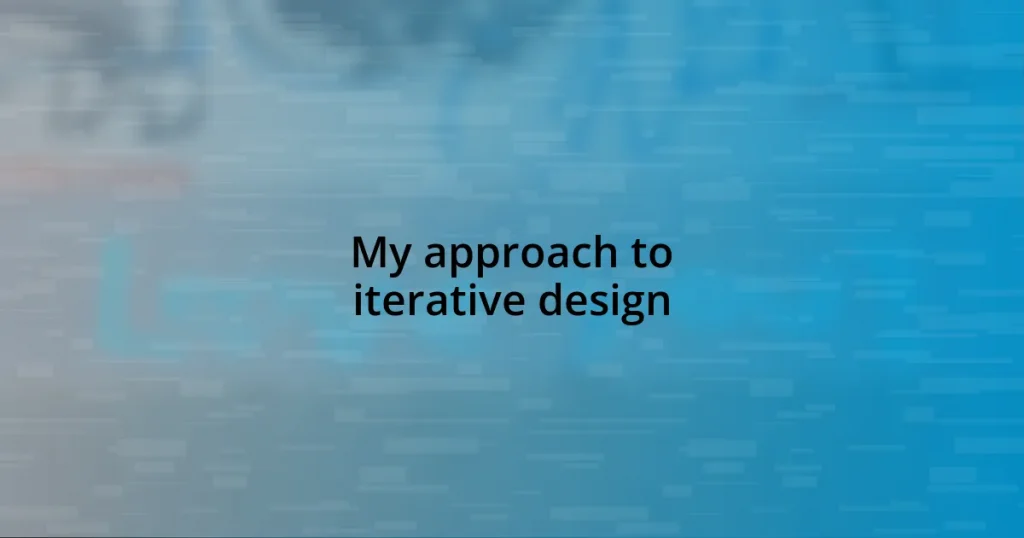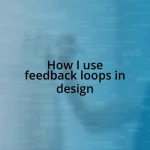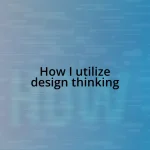Key takeaways:
- The iterative design process thrives on feedback, allowing for continual refinement and improvement based on user insights.
- Setting clear objectives for each iteration helps focus the design process and measure success effectively.
- Documenting the design journey enhances reflection, providing valuable context and showcasing growth over time.
- Incorporating diverse user feedback is crucial, as it can lead to unexpected breakthroughs and a more user-centric design.
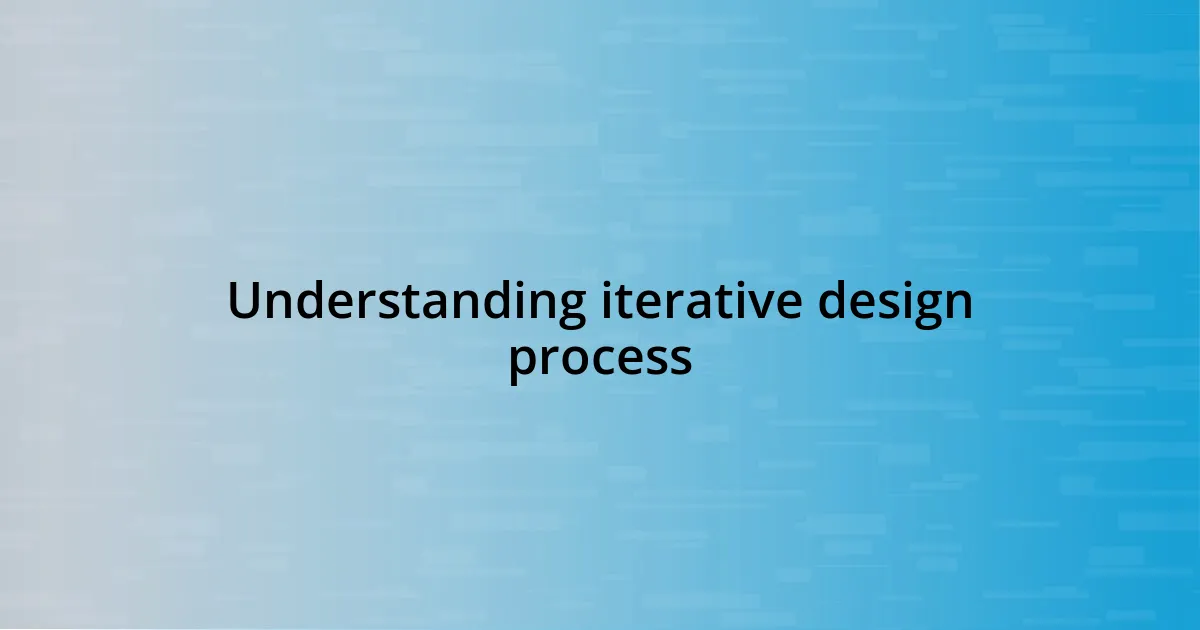
Understanding iterative design process
The iterative design process is all about embracing change and continual improvement. I recall a project where the initial layout I created just didn’t resonate with users. After gathering feedback, I realized the importance of stepping back and understanding the needs of my audience. Have you ever felt that shift in perspective after receiving critique?
In my experience, each iteration provides a chance to refine ideas based on real-world usage. I remember tweaking a feature multiple times, only to discover how small adjustments could create significant impacts. It’s like sculpting; every chip away from the stone reveals something that feels more authentic and user-centric.
One of the most powerful aspects of iterative design is that it allows for experimentation without fear. There were moments when I was hesitant to alter what I believed was the “perfect” design, only to find that stepping into the unknown led to much better solutions. Isn’t it fascinating how a little uncertainty can lead to innovation? The iterative process turns challenges into opportunities, guiding you toward a design that feels just right.
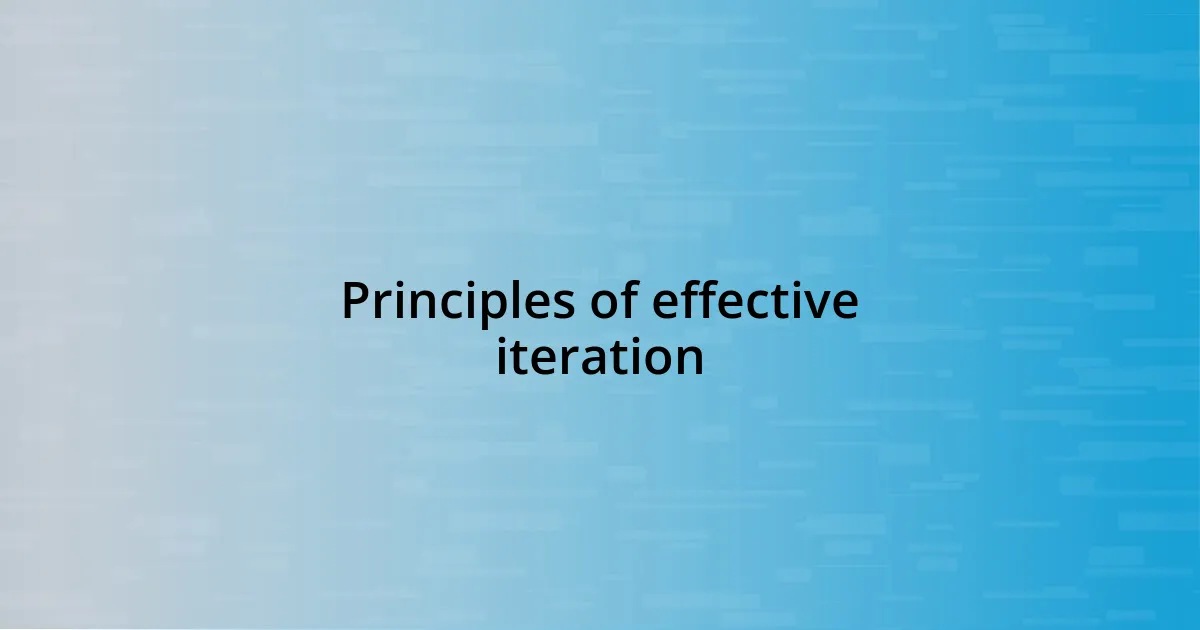
Principles of effective iteration
Iterative design thrives on the principle of feedback. When I first started embracing this methodology, I learned the hard way that ignoring user input can stall progress. I once clung to a color palette that I adored, but my users found it confusing. That moment was eye-opening; it reinforced how valuable constructive criticism is in shaping a successful design. Are you ready to take in feedback that might challenge your initial ideas?
Another cornerstone is setting clear objectives for each iteration. I often start with a specific aspect I want to improve upon. For instance, when redesigning an app feature, I focused solely on usability over aesthetics in one iteration. This focused approach allowed me to evaluate the user experience deeply. By narrowing my scope, I could achieve genuine progress, as each tiny win moved me closer to the grand vision.
Lastly, documenting the journey is crucial. I can’t stress enough how helpful it has been for me to keep track of my iterations—what worked, what didn’t, and the changes made. I remember revisiting past projects and realizing how far I had come. This transparency not only gives clarity but also fosters a reflective practice. It’s like having a progress diary that reveals growth in design thinking. Have you ever taken a moment to reflect on your journey through iteration?
| Principle | Description |
|---|---|
| Embrace Feedback | Actively seek and incorporate user feedback to inform design choices. |
| Set Clear Objectives | Establish specific goals for each iteration to focus the design process. |
| Document the Journey | Keep a record of changes and findings throughout iterations for future reference. |
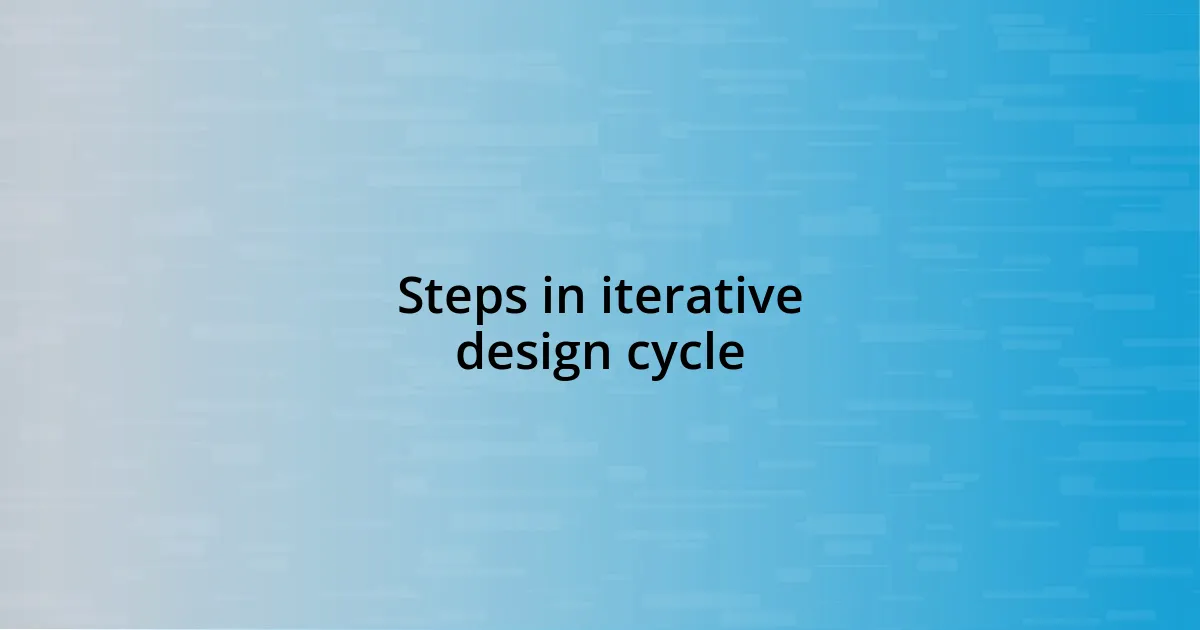
Steps in iterative design cycle
The iterative design cycle typically follows a series of critical steps that guide the development process. From my own experiences, I find that beginning with an initial design prototype sets the stage for valuable user feedback. After creating that first version, gathering insights from users becomes a pivotal moment. I remember feeling a mix of excitement and nervousness when I presented my design to a focus group. Their reactions shaped my next steps dramatically.
- Prototype Creation: Develop an initial version of the design based on your understanding of user needs.
- User Feedback: Collect input from real users to identify strengths and weaknesses.
- Refinement: Make adjustments based on feedback, continually enhancing the design in line with user expectations.
In the following phases, I often enter a loop of testing and further refining, which I see as a thrilling yet challenging process. Each iteration reveals fresh perspectives and opens doors to new improvements. I distinctly recall a project where the first two rounds of feedback left me frustrated, but with determination, I tackled the issues head-on. The breakthrough came when I realized that sometimes stepping back to redefine my approach was necessary. It was a valuable lesson in embracing the iterative cycle, where persistence pays off.
- Testing: Evaluate the revised design to see if it meets the desired goals and user needs.
- Analysis: Reflect on testing outcomes and pinpoint areas for further enhancement.
- Iteration: Repeat the cycle until the design reaches a level of satisfaction, ideally one that resonates with users.
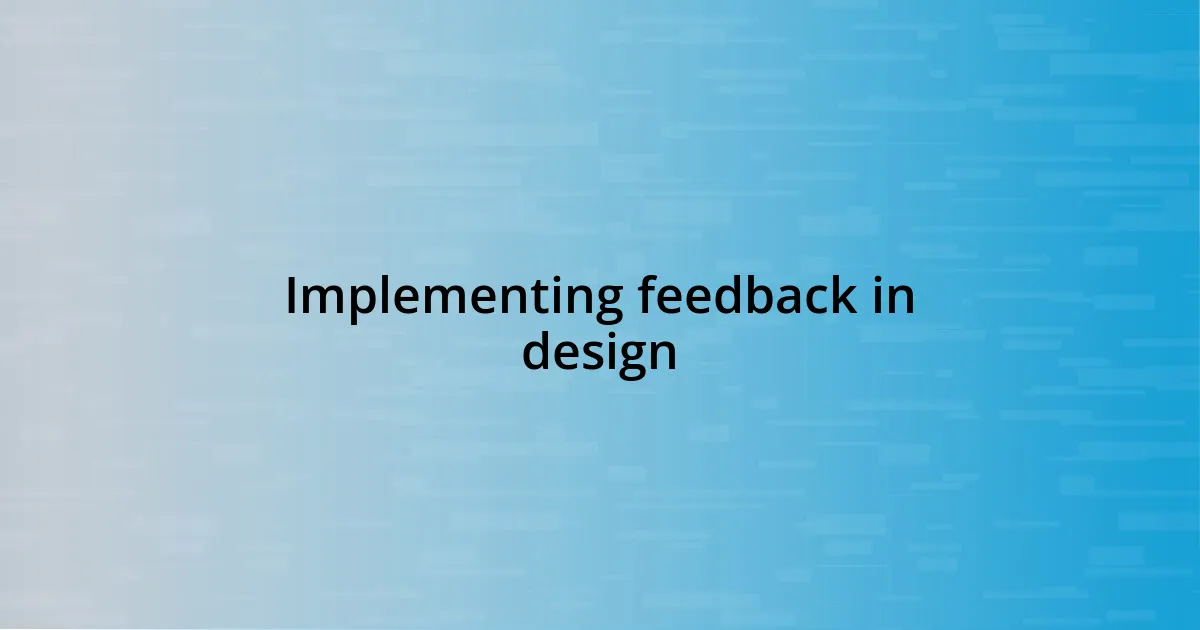
Implementing feedback in design
Incorporating feedback into the design process isn’t just a step; it’s the heartbeat of iteration. I remember a project where I carefully gathered user input only to discover significant usability issues I’d overlooked. It felt frustrating at first, but that feedback allowed me to pivot in a direction that genuinely resonated with users. How often do we hesitate to confront our blind spots?
As I’ve navigated through implementing feedback, I’ve found that synthesizing diverse suggestions is crucial. For example, during one redesign, users provided feedback that contradicted my instincts. Realizing the value of this input was a turning point. It taught me not to get too attached to my ideas and understand that user experiences often hold the key to impactful design.
The beauty of this process lies in the evolution of ideas sparked by constructive criticism. There was a time when I learned to appreciate even the harshest feedback; it has often led to unexpected breakthroughs. Each piece of user feedback brings me a step closer to what they truly need, transforming what I thought was a perfect design into something far better. Isn’t it fascinating how listening can unlock potential we hadn’t even considered?
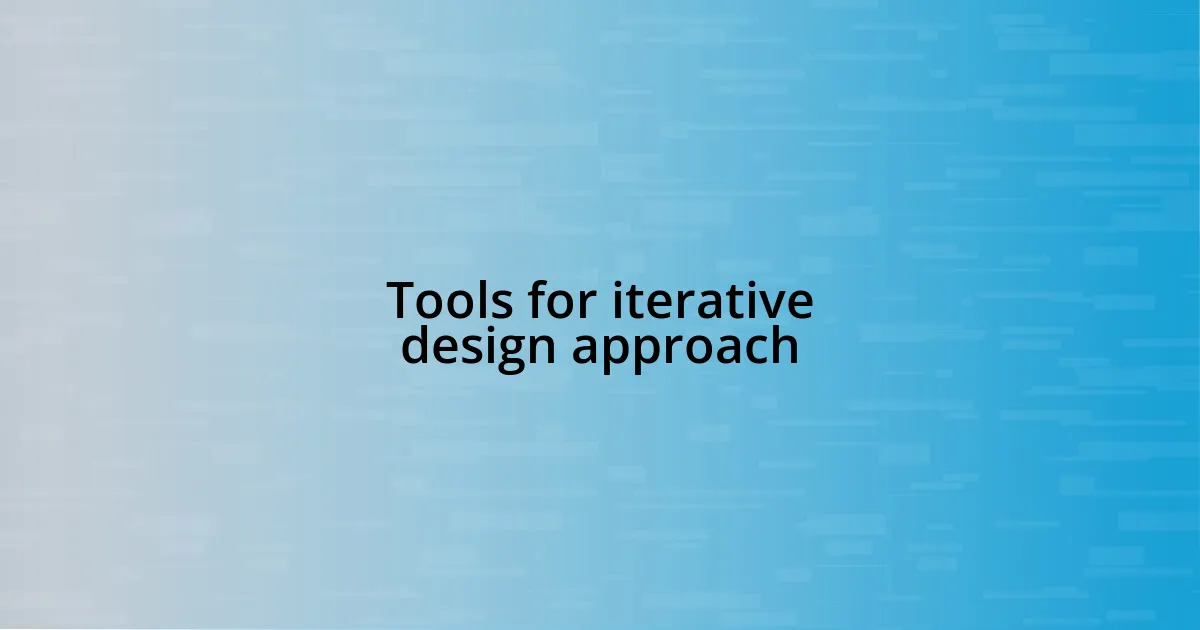
Tools for iterative design approach
When it comes to tools for an iterative design approach, I’ve found that prototyping software is essential. For instance, platforms like Figma or Adobe XD allow me to quickly create interactive designs that I can share with users for feedback. I remember a time when I crafted a mobile app interface in Figma, and seeing users interact with it in real-time provided insights that static mockups simply couldn’t convey. Have you ever experienced that thrill of watching someone navigate through your design? It’s a rush!
Another valuable tool in my toolkit is user testing platforms, such as UserTesting or Lookback. These services enable me to gather real-time feedback from users as they interact with my designs in a controlled environment. I distinctly recall a session where a participant struggled with navigation in an early version of my design. Their frustration became a treasure trove of insights, guiding me to prioritize clarity in the next iteration. It’s incredible how one user’s experience can shift my entire perspective.
Let’s not forget the power of collaboration tools like Miro or Trello. I’ve found that brainstorming and maintaining an ongoing dialogue with my team through these platforms can fuel the creative process and keep adjustments seamless. I vividly remember a project where sharing ideas on Miro sparked a discussion that led to a fundamental shift in our approach, blending multiple perspectives into a coherent design. Collaboration tools make it feel as if every voice matters—how empowering is that?
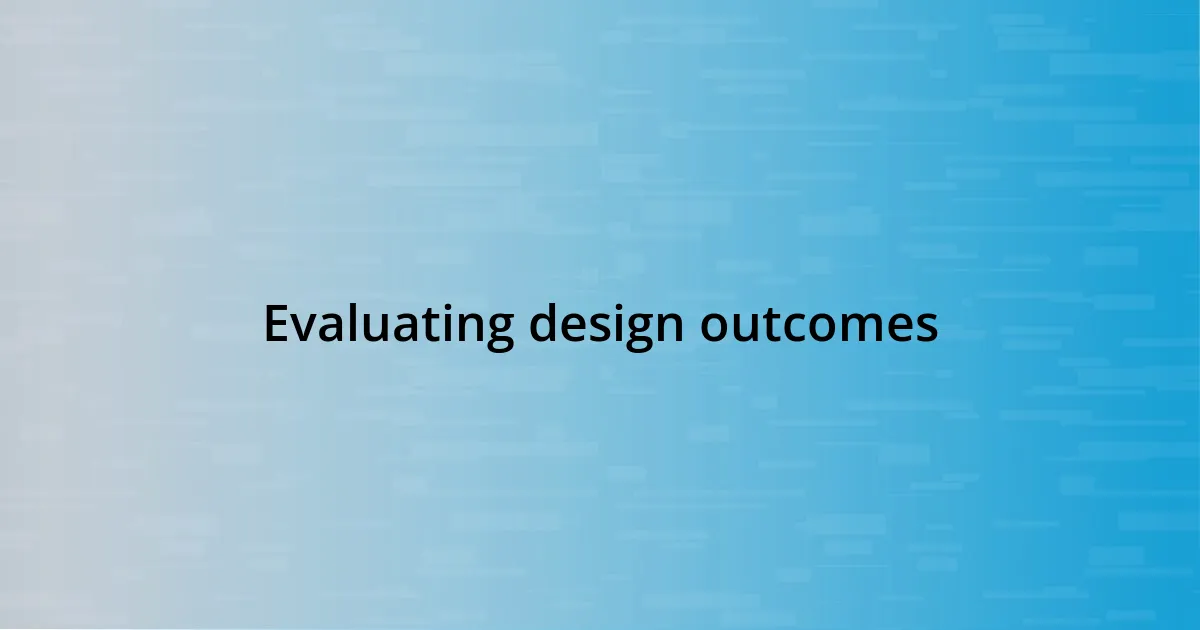
Evaluating design outcomes
Evaluating design outcomes is an essential step in the iterative process that often reveals the effectiveness of our design decisions. I remember a time when I released a new feature and, after evaluating user interaction data, I discovered that only a fraction of users engaged with it. It was a real eye-opening moment for me—how can I adapt if I never take stock of what works and what doesn’t?
In addition to analyzing quantitative metrics, qualitative feedback plays a significant role in evaluation. For instance, after a recent release, I conducted a series of follow-up interviews with users. One insightful comment stood out: a user mentioned that while the design was visually appealing, it lacked intuitive navigation. This revelation made me realize that aesthetics should never overshadow functionality. Have you ever faced a situation where feedback changed your entire design perspective?
Ultimately, I believe that evaluating design outcomes is not a final step but an ongoing dialogue. Each outcome teaches me something new, nudging my understanding of user needs further. Reflecting on these evaluations has often led me to innovative solutions I initially overlooked. Isn’t it fascinating how these moments of reflection can inspire my next wave of creativity?
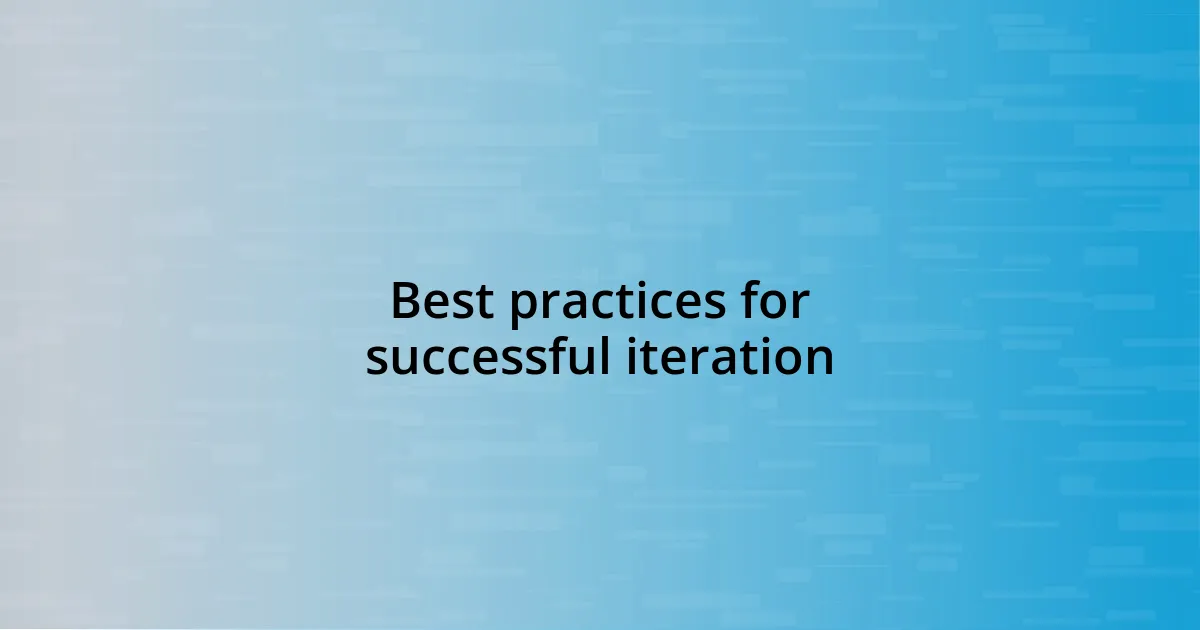
Best practices for successful iteration
Successful iteration hinges on embracing feedback at every stage of the design process. I recall an instance when I presented a mid-project prototype to a group of users. Their candid reactions were a mix of confusion and excitement, but what struck me most was how their insights transformed my understanding of the design’s purpose. It was like peeling back layers to reveal what truly resonated with them. Have you ever felt that shift in perspective after real user feedback? It’s profoundly rewarding.
Another practice I can’t stress enough is setting clear goals for each iteration. During one project, we aimed to improve load times while enhancing visual appeal. By focusing specifically on those objectives, we were able to measure our success more effectively and iterate based on defined criteria. It was satisfying to see how a clear vision directed our efforts and streamlined our discussions. Isn’t it amazing how clarity can make the iterative journey feel more focused?
Lastly, don’t underestimate the power of documenting your iterations. I’ve made it a habit to keep a design diary where I note changes, rationale, and insights from each round of feedback. Reviewing these notes not only provides context for future designs but also serves as a reminder of how far I’ve come. It’s like having a conversation with my past self—what a reflective experience that can be! How often do you take a moment to appreciate your design journey? It can be enlightening!










